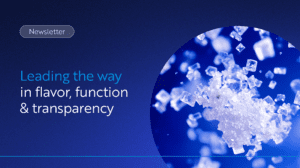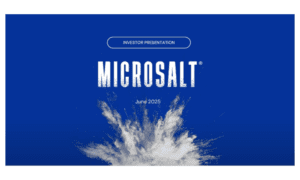Science draws clear lines on where sodium intake enters the red. Review our guide to stay in line with your sodium production and consumption goals.
Key Takeaways:
- Low-sodium foods contain less than or equal to 140 milligrams
- Low sodium is different from reduced sodium
- Most Americans far exceed their recommended daily sodium intake
- Lowering your sodium intake by consuming low-sodium foods can reduce your risk for hypertension and cardiovascular disease
Sodium is one of the most important minerals the body needs to function optimally. It maintains the appropriate balance of water in the body and facilitates the conduction of nerve impulses and the movement of muscles. The Centers for Disease Control and Prevention (CDC) recommends a maximum daily intake of sodium for adults of 2,300 mg, which is the equivalent of one level teaspoon of salt (5 mg of salt).
Consuming too much sodium can trigger hormonal and metabolic complications. This includes the water retention that can result in persistent high blood pressure and cardiovascular complications.
Cardiovascular disease is the leading cause of death in the U.S. Science is revealing a link between sodium reduction and a reduced risk for cardiovascular disease. The CDC has recommended measures to reduce sodium intake and consequently mitigate cardiovascular disease morbidities and mortalities.
Now that we know the higher limits for sodium intake, we need to understand the lower limits. How low is low sodium?
Low sodium definitions
The following measures apply when determining low sodium:
Low sodium: Foods that contain less than or equal to 140 mg of sodium in one recommended serving are generally considered low sodium.
A “very low-sodium” product will have less than or 35 mg of sodium per serving.
Sodium-free: These foods will have fewer than 5 mg of sodium per serving.
Reduced sodium: Reduced sodium should not be mistaken for low sodium. “Reduced sodium” on a product label means that the sodium in that item has been reduced by 25% compared to a regular product. A reduced-sodium product does not necessarily qualify it to be a low-sodium product. For example, a bag of potato chips reading reduced sodium may contain 750 mg of sodium, down from 1,000 mg. The sodium level is higher than the recommended daily intake, despite it being “reduced.”
The recommended sodium requirements
The recommended daily intake of sodium for adults is 1,500 mg. This means that consuming a
low-sodium product of 140 mg supplies you with 9% of your daily requirement. You could reasonably have eleven such products or meals in a day.
Exceeding 2,300 mg of sodium per day is considered excessive sodium consumption. This increases your risk for hypertension and heart disease.
How to keep your sodium consumption low
Approximately 90% of Americans consume more sodium than is healthy, according to an issue of American Journal of Clinical Nutrition published in September 2012. Over 70% of consumed sodium is found in prepared and packaged foods. The U.S. Food and Drug Administration (FDA) is working with the food industry to ensure the reduction of sodium in commercially prepared foods. You can also take steps to work toward your personal sodium reduction goals. This may include the following:
1. Read the label
Use the Nutrition Facts label as your tool for determining your sodium intake. Apart from apparent and daily values, you can use the Percent Daily Value (%DV) to determine how high in sodium a serving is. The percentages throughout the day should add up to less than 100% DV. For example, a product with 5% DV of sodium or less per serving is considered low, while 20% DV of sodium or more per serving is high.
2. Pay attention to servings
Look for the definition of a serving, usually provided on the top part of the Nutrition Facts panel. The listed nutrition information is usually based on a single serving. Check the serving size and apply that to your serving size and number of servings to determine the amount of sodium you have consumed.
3. Not all sodium comes from salt
The words “table salt” and “sodium” are many times used interchangeably. However, they are not the same thing. Table salt (chemically known as sodium chloride) is a crystal-like compound that is abundant in nature. Sodium is a mineral on its own but is just one component of table salt.
Table salt contributes the highest amount of sodium that we consume regularly. Other forms of sodium used in baking, to cure meat, enhance flavor, retain moisture, as a thickening agent, and even as a preservative also contributes to the overall sodium intake.
Other common forms of sodium that are consumed include:
- Sodium bicarbonate (baking soda)
- Monosodium glutamate (MSG)
- Sodium benzoate
- Sodium nitrite
Some foods that do not taste salty at all can still contain high amounts of sodium. Therefore, it is important to scrutinize nutrition labels very carefully. Foods like bread that are not necessarily high in sodium may result in high sodium intake if consumed repeatedly over the course of the day.
Most Americans far exceed their recommended daily sodium intake. Your body needs sodium in low quantities to work properly, but too much of it can adversely affect your health. We have outlined what a low-sodium diet entails and adhering to this will ensure that you are reducing your sodium levels.
But there’s an easier way to lower your sodium intake.
MicroSalt® keeps your sodium intake in check
MicroSalt® ultra-fine salt particles have double the flavor of salt but have only half the amount of sodium than regular salt. This allows you to savor each flavorful bite without having to worry about extra sodium.
The MicroSalt® team strives to create a new food industry norm where good health doesn’t come second to great taste MicroSalt® are proud global winners of the P&G Alumni Network’s 2021 Star Entrepreneur Award. We’d love to take part in making your product the best it can be. Simply contact us via our contact page, connect with one of our international offices, or call 1 (877) 825-0655 to learn more.




